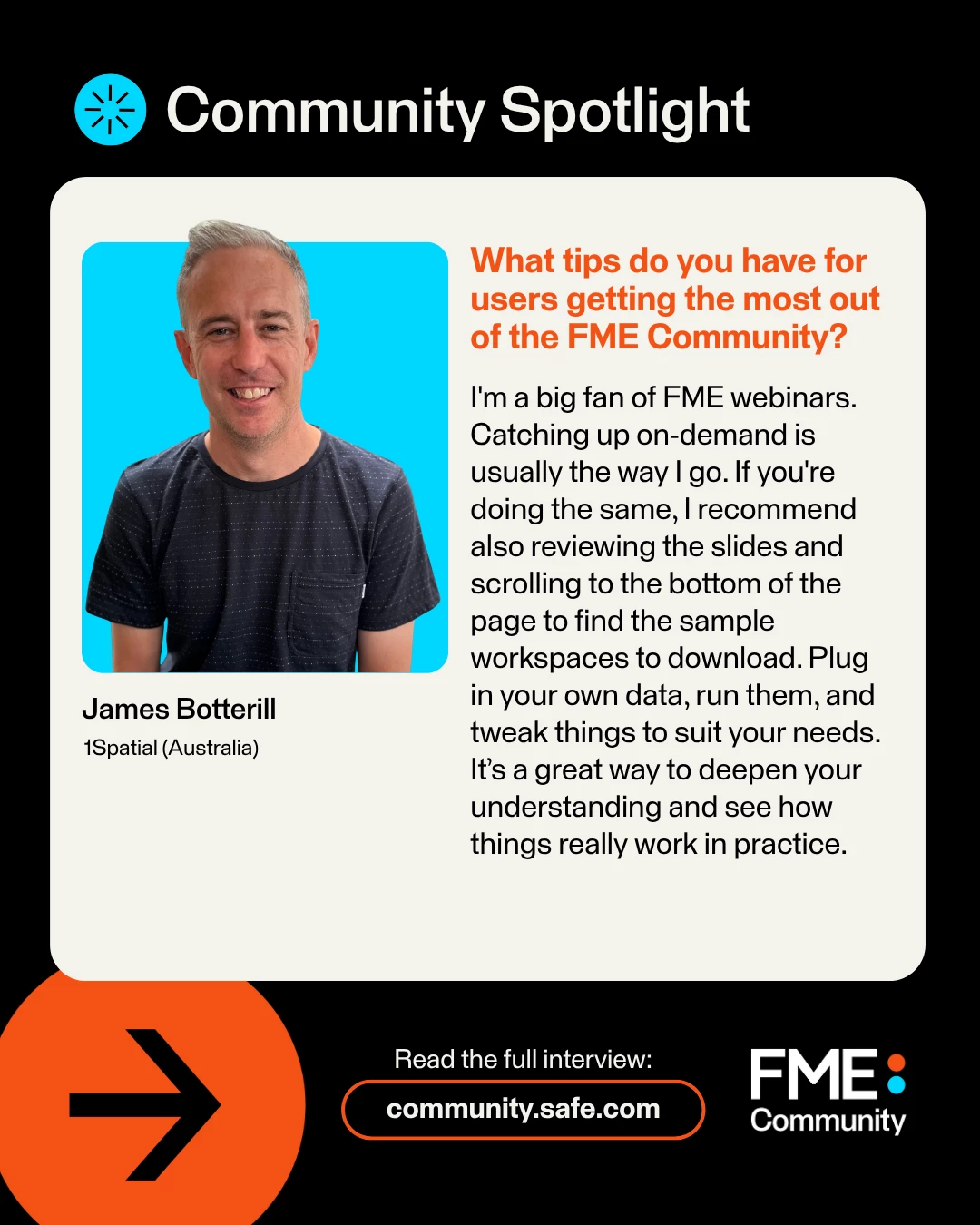Welcome to our November FME Community User Spotlight! Every month, we’ll be spotlighting a user in the community whose active participation and helpful contributions have been invaluable to the community. We’re excited to highlight their experiences and insights!
User Spotlight: @j.botterill
What company do you currently work for?
1Spatial in Australia
What’s your current job role and title?
Senior Consultant
Tell us more about what you do and how you use FME?
As part of our consulting services, we assess client requirements and identify their key challenges in order to deliver tailored integration solutions using FME Form and Flow. We offer strategic guidance on best practices and governance frameworks, enabling large organizations to maximize the value of their FME Platform investment. Our team supports the deployment of FME Flow Enterprise, often in distributed environments and we work with clients to install the FME engine closer to their data stores. To ensure ongoing success we deliver certified, instructor-led FME training with several courses running each month.
Why did you join the FME Community?
I started using the community on an ad hoc basis before getting more involved during Covid-19, finding it a great place to collaborate. It really helped me learn more, and much quicker. When life returned to the new normal, I never left and I'm still engaged today because the forum is full of incredibly supportive and knowledgeable people.
I enjoy seeing Safers contributing regularly offering what I like to call “support plus” advice. The community events that run are a huge highlight and in recent years they’ve become quite challenging and innovative.
What tips do you have for users on how to get the most out of the FME Community?
I'm a big fan of FME webinars. The live sessions don’t always line up well with our time zone here in Australia, so catching up on-demand is usually the way I go. If you're doing the same, I recommend also reviewing the slides and scrolling to the bottom of the page to find the sample workspaces to download. Plug in your own data, run them and tweak things to suit your needs. It’s a great way to deepen your understanding and see how things really work in practice.
Tell us about some of the exciting use cases you’ve built using FME.
Prior to the latest FME release of Realize, I participated in a proof of concept (PoC) integrating Augmented Reality (AR) into field operations for an electrical utility, using FME Flow (hosted). This initiative demonstrated that FME’s spatial analysis capabilities significantly outperform other tools in identifying related assets. Within 60 seconds the field asset officers were able to access an AR experience on their iPads to visualize hidden restricted or buried assets such as High Voltage Switchgear, enabling faster response to outages and enhancing safety during asset maintenance.
One of the primary challenges faced by non-technical staff was orienting the AR model within real-world space, as it lacked a geographic reference framework. To overcome this, high precision GNSS and writing out a north-trending reference line was introduced from the anchor point. This enhancement enabled users to manually rotate and align the AR model with greater spatial accuracy, improving contextual understanding and usability.
Another increasingly important use case involves building a companion database alongside FME Flow. Such a DBMS—commonly PostgreSQL, Oracle, or SQL Server - can be leveraged to store and manage source and destination transformation rules and can help an organization automate the tracking of incremental loading processes, maintaining a detailed audit trail of job execution status, and facilitate the review and troubleshooting of transformation errors.
FME workspaces can use transformers like the FeatureReader, SQLexecutor or DatabaseQuerier to read from and write to the companion database. This approach supports robust data governance, enables more granular monitoring, and streamlines the maintenance of complex, evolving data pipelines.
What’s one of your favourite tips or tricks for using FME?
Where possible, leverage open data web services provided by your municipality / government agencies.
I find myself often creating HTML reports to summarise data loading operations. Using a number of HTMLreportgenerator followed by sorter and layouter, I use custom html and include tables of key results—such as records loaded, errors, and status. Adding an Esri Leaflet map to highlight any problem features can enhance the spatial context understanding for a user by adding open web service to the “Feature Layer URL”, generally the ArcGIS REST address.
Please take a moment to upvote any ideas related to htmlreportgenerator — it could really use some fresh updates. Enhancements like improved Leaflet support, better styling, and even AI-assisted generation of structured custom HTML (for example, attribute-based pop-up widgets) would make a big difference. Shout out to @Alexbiz has done an amazing job deploying BetterReportGeneration (BRG).
In a somewhat similar manner, I'm keen to explore more how Dmitri utilises javascript in “connected experiences” through the use of intermediate linking in the toolbox UI used in the FME Realise Flow apps
If you were stranded on an island and could only bring three things with you, what would they be?
- Barista coffee machine with battery/solar backup
- (long life?) milk
- Deploy a 'desalinator' transformer to get fresh water
If you could work from anywhere in the world, where would it be?
I guess I've been lucky enough to have achieved this already! During our time living in Germany, I had the pleasure of working with con terra, where I thoroughly enjoyed working with their talented team on some fantastic projects, before needing to return home to Australia - I’d love the opportunity to do it all again someday!




